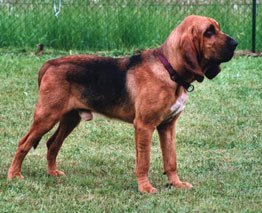(Original title: Bloodhound Dog Breed Profile)
 |
| Bloodhound (Photo credit: Wikipedia) |
Description:
The Bloodhound is considered to be a large type of hound. The dog will weigh between 90 and 110 pounds and the bitch 80 to 100 pounds. The height at the withers will be 25 to 27 inches for the dog and 23 to 25 inches for the bitch. The Bloodhound is recognizable for its wrinkled head, long ears, and soulful expression. The coat of the Bloodhound is short and has a hard texture and is predominantly liver and tan, black and tan, or red. The Bloodhound has a life expectancy of 10 to 12 years. This dog is also known as the Flemish Hound, the St. Hubert Hound, and the Chien de Saint-Hubert.
History:
The Bloodhound is an ancient breed, dating back over 1,000 years. The Bloodhound probably originated in France but was perfected by the Monks of St. Hubert in Belgium. The name Bloodhound refers to the purity of its blood, not to any vicious qualities. The Bloodhound was taken to England during the Norman Conquest and was a favorite breed with the royal house for years thereafter. The Bloodhound was used primarily as a hunting dog for stags. Gifts of Bloodhounds were given to the Kings of France by the monks from Monastery of St. Hubert. Later, the exceptional nose of the Bloodhound was used in tracking criminals and lost children.
Temperament:
Despite popular literature, the Bloodhound is one of the sweetest natured dogs. This dog is calm and gentle and can be trusted with children. Actually, the Bloodhound will sometimes have to be protected from children that want to play too vigorously with it, as it will not protest against harsh treatment. The Bloodhound loves to be in the midst of its family, interacting with them, and receiving attention. It is a loyal and devoted dog that is mild and patient.
Health Issues:
The Bloodhound is a dog that is quite susceptible to bloat and care should be taken to do everything possible to prevent this condition. Feed the dog 2 or 3 small meals a day, rather than one large one, and keep the dog inactive for an hour after eating. If your Bloodhound does develop bloat, take it to the veterinarian immediately. Bloat is a life-threatening condition. The Bloodhound can suffer from hip dysplasia. Eye problems can also surface, especially entropion.
Grooming:
As the Bloodhound has a short coat, a good brushing once a week will serve to keep it in good condition. As the Bloodhound has a rather strong 'doggy odor', the owner might like to give it a dry shampooing once in a while. The ears of the Bloodhound should be checked daily to make sure they are clean and dry. The pendulous ears make it easy for infections to begin.
Living Conditions:
The Bloodhound is an affectionate dog and will do best in the house with its family, even though it is able to live outside. This dog is capable of living in an apartment if it is given sufficient exercise. The Bloodhound is a dog that loves to follow a scent and should be allowed to work off some energy in a daily walk.
|
